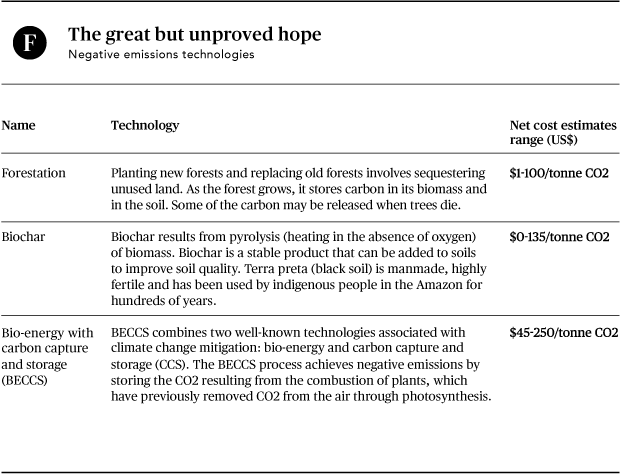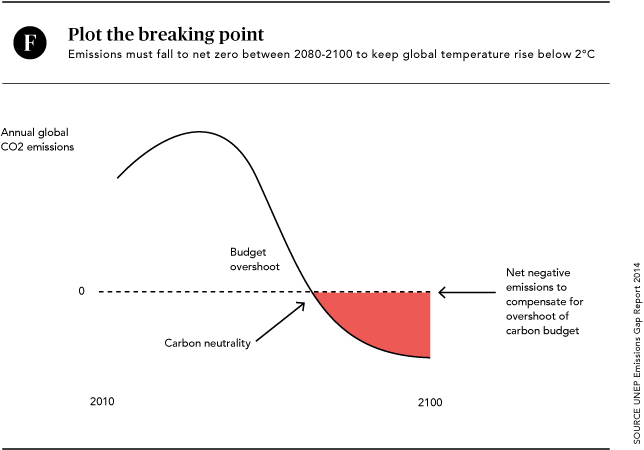CARBON CAPTURE AND STORAGE
Negative emissions may sound like the latest descent into climate-speak, but they are fast becoming a much talked about concept in the climate and energy discussion. In the second half of this century, reabsorbing and storing more CO2 from the earth’s atmosphere than is created through industrial activity is increasingly referred to as a crucial weapon for successfully combating climate change. Tobias Nielsen at Lund university, Sweden, shares his thoughts on the topic.
Negative emissions is shorthand for the removal of carbon from the earth’s atmosphere, mainly through photosynthesis. In theory, the captured emissions are stored in plants on land, underground or absorbed in oceans. Achieving negative emissions has the potential to bridge the likely “emissions gap” to full decarbonisation should conventional mitigation efforts falter. The big question, however, is whether pursuing negative emissions will be a vital tool, or a dangerous distraction.
The main technologies for achieving negative emissions are planting new areas with forest, reforestation of previously wooded areas, bioenergy with carbon capture and storage (BECCS) and biochar (see table). The technologies are needed primarily for two reasons.
First, some emissions are almost impossible to eliminate, such as those from agriculture and aviation. Paddy fields for rice cultivation and cows will continue to emit methane, while passenger aircraft are unlikely to run on electric power or hydrogen any time soon.
Second, proponents argue that negative emissions technology must be brought into play to compensate for the slow pace of conventional mitigation measures (see figure). Under the 2015 Paris climate agreement, countries aim to put in place pathways that can lead to so-called net-zero carbon emissions by 2050. In other words, carbon released during anthropological activity needs to be balanced by removing an equivalent volume of carbon from the earth’s atmosphere. Many national scenarios for reaching net-zero emissions and projections by the Intergovernmental Panel on Climate Change (IPCC) rely heavily on negative emission technologies.
DANGEROUS DISTRACTION
Depending on future negative emissions technologies to make up for an inability to reduce emissions today does not come without risks. It may inadvertently postpone critical and difficult climate action. Some policy makers are banking on future negative emissions redressing the damage done today and there are countries with climate action plans reliant on future increases of forest area.
The ability of negative emissions technology, widely deployed, to deliver the promised CO2 reductions has yet to be proved. One IPCC report puts the potential at 1000 gigatonnes of CO2, while other studies question the significance of their implementation. Moreover, widespread deployment of negative-emissions technologies may involve unacceptable ecological and social impacts. Even if significant increases in forested areas could be achieved, securing the land requires competing with rising demand for it from the agricultural industry and for bioenergy crops.
BECCS is widely viewed as the negative emissions technology offering the best potential for drawing significant quantities of CO2 from the atmosphere. A recent study published by Nature, an international popular science journal, indicates BECCS could be used to sequester around 12 billion tonnes of CO2 a year globally. Scaling up bioenergy production to achieve that level would almost inevitably take land needed for food crops and biodiversity conservation.
Meantime, the viability of storing vast quantities of CO2 underground remains unproved and has yet to be fully explored in practice. It is proving to be costly.
ETHICAL QUESTION
The whole concept of negative emissions raises a sensitive ethical question. Should the people of today continue to rely on tomorrow’s technological developments to solve the challenges being passed down to future generations?
Negative emissions technologies are potentially destined to play a key role in achieving emissions reduction targets, but their scalability and performance remains uncertain. Some regions are better able to accommodate increases in forest areas or test BECCS projects, but to depend heavily on negative emissions technologies may set the world on a high-temperature pathway. •
TEXT Tobias Nielsen, Lund University

